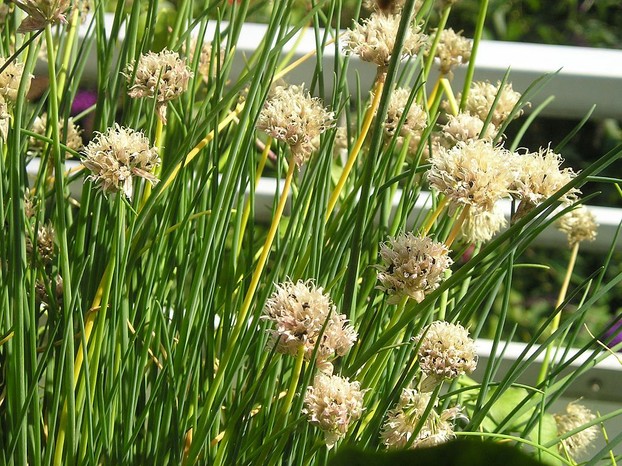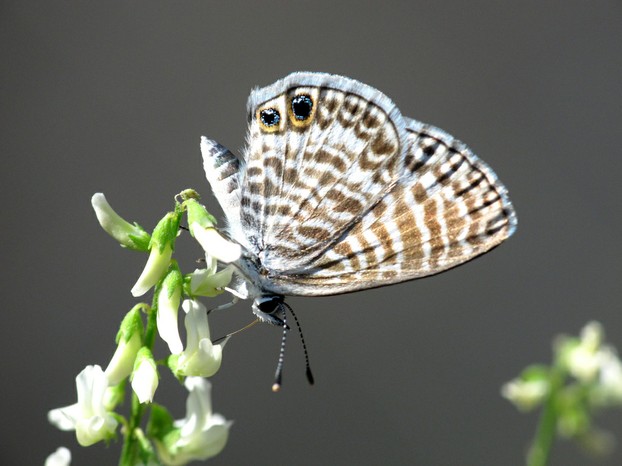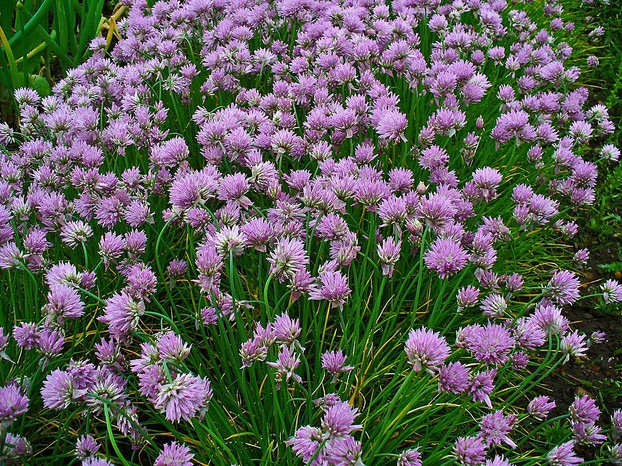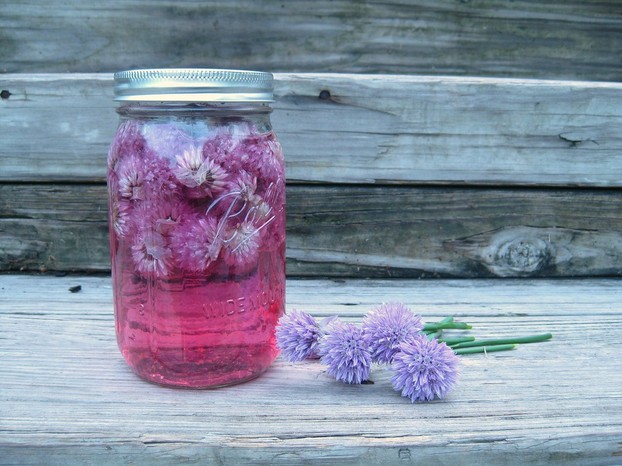Allium schoenoprasum opens in New Hampshire: Captain-tucker, CC BY-SA 3.0, via Wikimedia Commons @ https://commons.wikimedia.org/wiki/File:Allium_schoenoprasum_in_NH_03.jpg
Allium schoenoprasum: Fornax, CC BY-SA 3.0, via Wikimedia Commons @ https://en.wikipedia.org/wiki/File:Allium_schoenoprasum_W.jpg
closeup of Allium schoenoprasum floral head: pixhektar, CC BY-SA 2.0, via Flickr @ https://www.flickr.com/photos/pixhektar/5755321653/
Amager Fælled, København ("Amager Commons, Copenhagen"): Jann Kuusisaari, CC BY 2.0, via Flickr @ https://www.flickr.com/photos/jann_kuusisaari/5676421319/
"Chives small three-valved capsule with seeds": Noebse, Public Domain, via Wikimedia Commons @ https://commons.wikimedia.org/wiki/File:Chives_small_three-valved_capsule_with_seeds.jpg
Cougar Mountain Regional Wildland Park, Renton, Washington: Walter Siegmund, CC BY-SA 3.0, via Wikimedia Commons @ https://en.wikipedia.org/wiki/File:Celastrina_ladon_03745.JPG
Spring Azure (Celastrina ladon): Megan McCarty, CC BY 3.0, via Wikimedia Commons @ https://commons.wikimedia.org/wiki/File:Spring_Azure,_Megan_McCarty115.jpg
San Andres National Wildlife Refuge, Las Cruces, south central New Mexico: M. Weisenberger/USFWS, Public Domain, via San Andres National Wildlife Refuge Photo Gallery @ https://www.fws.gov/southwest/refuges/newmex/sanandres/Photoshop_gallery/Invertebrates/index.html
White Slough, near Lodi, northern Central Valley, California: Calibas, CC BY-SA 3.0, via Wikimedia Commons @ https://en.wikipedia.org/wiki/File:Plebejus_acmon2.jpg
Roma, southern tip of Texas: Bill Bouton, CC BY-SA 3.0, via Encyclopedia of Life @ https://eol.org/pages/269634/media/ (specific EOL image URL @ https://eol.org/media/9536883)
Lake Gregory, southern California: siamesepuppy, CC BY 2.0, via Flickr @ https://www.flickr.com/photos/siamesepuppy/7958296856/
Ashland, southwestern Oregon: Bill Bouton, CC BY-SA 3.0, via Encyclopedia of Life @ https://eol.org/pages/174202/media/ (specific EOL image URL @ https://eol.org/media/9541329)
Caribou Bog, near Nederland, southwestern Boulder County, north central Colorado: Bill Bouton, CC BY-SA 3.0, via Encyclopedia of Life@ https://eol.org/pages/174202/media/ (specific EOL image URL @ https://eol.org/media/9541328)
Wildwood Preserve Metropark, Toledo, northwestern Ohio: Benny Mazur (Benimoto), CC BY 2.0, via Flickr @ https://www.flickr.com/photos/benimoto/1519079685/
Scarborough, eastern Toronto, southern Ontario, east central Canad: outdoors2magic, CC BY-SA 2.0, via Wikimedia Commons @ https://commons.wikimedia.org/wiki/File:Colias_eurytheme_outdoors2magic.jpg
Botanical Garden Karlsruhe Institute of Technology (KIT), Germany: H. Zell, CC BY-SA 3.0, via Wikimedia Commons @ https://commons.wikimedia.org/wiki/File:Allium_schoenoprasum_001.JPG
garden in Belgium: Jamain, CC BY-SA 3.0, via Wikimedia Commons @ https://commons.wikimedia.org/wiki/File:Allium_schoenoprasum_J1.JPG
chive flower vinegar: Jax House, CC BY SA 2.0, via Flickr @ https://www.flickr.com/photos/jaxhouse/5786047479/
"Spirou in allium schoenoprasum"; Les Bulles, Luxembourg province, southern Belgium: Alexandre Dulaunoy, CC BY SA 2.0, via Flickr @ https://www.flickr.com/photos/adulau/2473960581/































 Are Hawaiian Huakai Po Nightmarchers Avenging Halloween Thursday?on 10/02/2024
Are Hawaiian Huakai Po Nightmarchers Avenging Halloween Thursday?on 10/02/2024
 Mailing Addresses for 2023 Form 4868 Extending 1040 and 1040SR April 15, 2024, Due Dateon 04/15/2024
Mailing Addresses for 2023 Form 4868 Extending 1040 and 1040SR April 15, 2024, Due Dateon 04/15/2024
 Mailing Addresses for 2023 Forms 1040 and 1040SR Filed in 2024on 04/15/2024
Mailing Addresses for 2023 Forms 1040 and 1040SR Filed in 2024on 04/15/2024
 Mailing Addresses for 2022 Form 4868 Extending 1040 and 1040SR April 18, 2023, Due Dateon 04/13/2023
Mailing Addresses for 2022 Form 4868 Extending 1040 and 1040SR April 18, 2023, Due Dateon 04/13/2023



Comments
Mira, Butterflies are indicators of the environment but they also go through cycles of plentiful and thinning populations.
The main county library here seems to be on a butterfly path because, as I rest my eyes from the computer, I see them flying high up one wall of the high-soaring windows and, after a few moments, swooping down along the opposite wall of windows.
May butterflies return to Bucharest.
The butterflies are so pretty. I wonder where they all have gone here in Bucharest. Do you see butterflies when you visit parks in cities. I don't! Isn't that strange?
frankbeswick, Assuredly the bees appreciate your thoughtfulness in allocating some of your chives for them. Actions such as yours contribute to harmony and balance in nature and in the world. They say that bees recognize faces and silhouettes (probably voices as well!), so you aren't a stranger to the bees who make a "bee-line" for your chives.
Chives are bee-friendly plants. I do not harvest them all on my plot, but leave some for the bees. You can see plenty of them feeding on the chive flowers.
The similarity of their leaves to rushes is due to the fact that rushes and members of the allium family [leeks,onions, chives] are a monocots, which is an order of plants that have long thin leaves and parallel veins.
2uesday, Definitely chives are cooperative about garden growing, including containers. Chives do seem to enjoy container growing, so they're also great for a window herb garden. Such a treat to grow chives, isn't it?